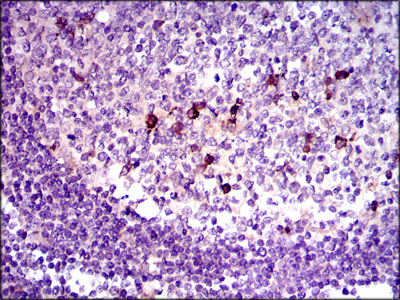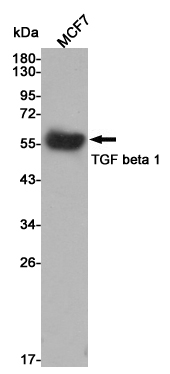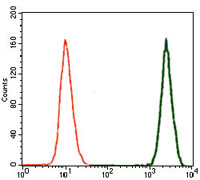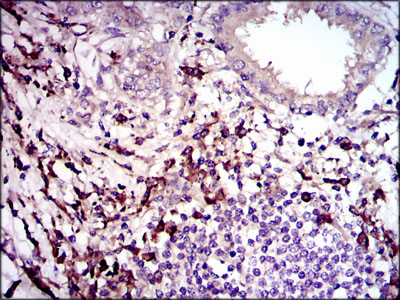-
Product Name
Anti-TGF beta 1 (3E7) Mouse antibody
- Documents
-
Description
TGF beta 1 (3E7) Mouse monoclonal antibody
-
Tested applications
WB, IHC-P, FC
-
Species reactivity
Human
-
Isotype
Mouse IgG1
-
Preparation
Antigen: Purified recombinant fragment of human TGFb1 (AA: 62-195) expressed in E. Coli.
-
Clonality
Monoclonal
-
Formulation
Purified antibody in PBS with 0.05% sodium azide
-
Storage instructions
Store at 4°C short term. Store at -20°C long term. Avoid freeze / thaw cycle.
-
Applications
WB: 1/500 - 1/2000
IHC: 1/200 - 1/1000
FC: 1/200 - 1/400
ELISA: 1/10000
-
Validations

Immunohistochemical analysis of paraffin-embedded lymphoid tissue tissues using TGFb1 mouse mAb with DAB staining.

Western blot detection of TGF beta 1 in MCF7 cell lysates using TGF beta 1 mouse mAb (1:1000 diluted).Predicted band size:45KDa.Observed band size:52KDa.

Flow cytometric analysis of A549 cells using TGFb1 mouse mAb (green) and negative control (red).

Immunohistochemical analysis of paraffin-embedded lung cancer tissues using TGFb1 mouse mAb with DAB staining.
-
Background
Swiss-Prot Acc.P01137.This gene encodes a member of the transforming growth factor beta (TGFB) family of cytokines, which are multifunctional peptides that regulate proliferation, differentiation, adhesion, migration, and other functions in many cell types. Many cells have TGFB receptors, and the protein positively and negatively regulates many other growth factors. The secreted protein is cleaved into a latency-associated peptide (LAP) and a mature TGFB1 peptide, and is found in either a latent form composed of a TGFB1 homodimer, a LAP homodimer, and a latent TGFB1-binding protein, or in an active form composed of a TGFB1 homodimer. The mature peptide may also form heterodimers with other TGFB family members. This gene is frequently upregulated in tumor cells, and mutations in this gene result in Camurati-Engelmann disease
Related Products / Services
Please note: All products are "FOR RESEARCH USE ONLY AND ARE NOT INTENDED FOR DIAGNOSTIC OR THERAPEUTIC USE"
